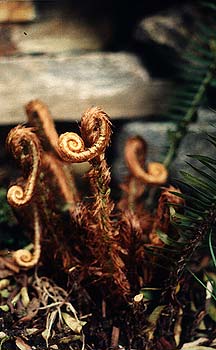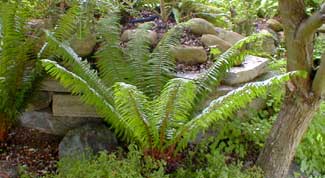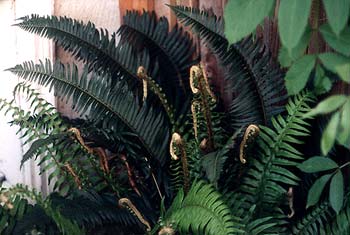 Western Sword Fern,
Western Sword Fern,
a native beauty
"And when the sunset reddened on our woods,
I came upon a pathway fringed with ferns,
That led through brushwood to a little dell,
All dreamy with its stillness 'mid the hills."
Augusta Webster
(1837-1894)
(1837-1894)
Northwesterners tend to take the swordfern (Polystichum munitum) for granted & many even neglect it as a garden treasure, being as it is something one sees along roadsides & in every wooded area without even searching for it. But to ignore our native swordfern while paying nursery prices for ferns only half as beautiful verges on absurd.
It's an awesome fern, among the largest of all evergreen types. It is at its most remarkable when spotted in the wild at low to medium elevations on moist forest floors, but tolerates considerable imperfection in its environment & once established even makes it through drought only a little worse for wear, quickly recovering.
Given shade & moist well-drained acidic soil, Western Sword Ferns are hardy as the dickens. Older fronds do die off, so the one trick of keeping them bright & gorgeous is to plant them accessibly so you're able to reach in to trim off the oldest under-fronds especially at the start of spring.
 We collected ours from clearcut areas where ferns & other understory plants were startled to find the trees removed & the sun considerably brighter than was to their liking. Two of our swordferns obtained on one trip were so heat-exhausted due to timber harvest, it was definitely saving their lives to dig them up. They are now shaded under a canopy created by a hawthorn tree, a paperbark maple, & the cotoneaster arbor, right at the side of a staircase where it is a cinch to prune the old fronds when required.
We collected ours from clearcut areas where ferns & other understory plants were startled to find the trees removed & the sun considerably brighter than was to their liking. Two of our swordferns obtained on one trip were so heat-exhausted due to timber harvest, it was definitely saving their lives to dig them up. They are now shaded under a canopy created by a hawthorn tree, a paperbark maple, & the cotoneaster arbor, right at the side of a staircase where it is a cinch to prune the old fronds when required.The crosiers shown above are new April growth on one of these salvaged ferns. I do not trim them back every year, but that time, as soon as the croziers were pretty enough to sustain the plant's decorative value without last year's leaves, I cut off nearly all the fronds that had slowly lost their attractiveness over winter. Sometimes very few fronds get ragged, but as this one was only one year in the ground & not fully recovered from its memories of the harsh clearcut, it got pretty ratty before winter's end, & I ended up removing all the old fronds but two, & even those needed to be cut off a month later.
The May (2004) photo second on this page is one of the same ferns a couple years later. The location is a bit droughty, but the ferns never show signs of stress, though slower in their growth rate than would be the case with a more persistant moisture.
 The two specimens by the stairs to the street will someday be so enormous they might get in the way of using the staircase, but I'll deal with that then, hoping I'll figure out how to trim them so they remain beautiful but don't entirely block the steps. If it ever becomes necessary, they can be divided in spring.
The two specimens by the stairs to the street will someday be so enormous they might get in the way of using the staircase, but I'll deal with that then, hoping I'll figure out how to trim them so they remain beautiful but don't entirely block the steps. If it ever becomes necessary, they can be divided in spring.The third photo taken in May (2002) is of an older specimen in a very protected area of the deepest somewhat droughty shade. I didn't have to cut off hardly any of the fronds as they made it through the winter mostly intact. But because the older fronds won't be doing any further growing in their second year, they get tatty later on & can be removed over time as they loose their looks. Saving them as long as possible as "underleaves" protects new growth from slugs & snails. Croziers burst from the center & unfold as newer fronds over the old.
The photo was taken just before the leaves were entirely unfolded so they have charming bends at the tips which will straighten & broaden into very wide fronds. It is sharing this space with a hosta which was only beginning to grow back when this picture was taken, but a week or so later was almost as big as the fern.
It was once believed it was necessary to cut all the fronds off in February immediately before new growth begins, but it is now the recommendation to only trim dead fronds. By April when the fiddleheads are thickly erupting, any of last year's fronds that have lost their beauty should be removed, but only for looks' sake, removing up to as many as all of them. They'll soon enough be replaced by new. Just don't remove the fronds before winter's final frosts, as the reason this fern adapted itself to keeping its fronds green at least until winters' end is to shelter & protect the humping crown from excessive cold or from sunlight in winter when deciduous trees might not adequately shade the rootcrown.